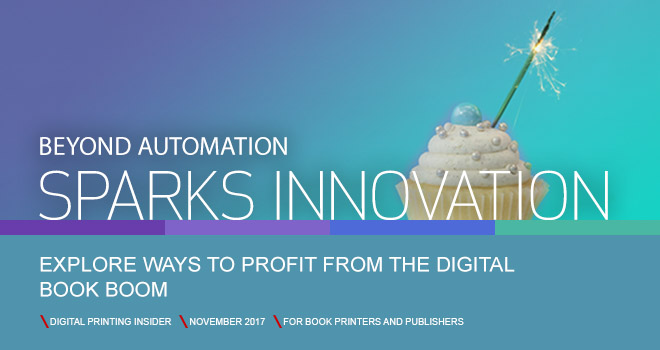Automating Digital Book Manufacturing
Technology is Changing Book Printing
There have been many changes in book printing over the past decade. E-readers have decreased the volume of printed books. Online retailers have changed the ordering and distribution process of books. As a result, publishers are looking to find new revenue streams from reprints, backlists, and out-of-print titles plus better control of costs and inventories.
All of this is fueling a migration to shorter and shorter print runs including on-demand book printing in quantities as small as one. The end result for book publishers is better control of inventory, a reduction in the number of unsold books, reduced storage costs, and opportunities to cost-effectively generate growth from limited markets, new markets like personalized and custom books, and self-published titles — ?all the while ensuring they can do so more profitably.
Production inkjet enables every small order to be produced incredibly efficiently and run seamlessly as part of a much larger print run batch.
Production inkjet technology is ideally suited for the manufacture of short-run books due to its speed, flexibility, quality, color affordability, and cost efficiency. This technology gives publishers a new level of control over managing inventory, enabling them to adjust their strategy as demand wanes or surges for individual titles, and helping ensure that what they produce they sell. Production inkjet enables every small order to be produced incredibly efficiently and run seamlessly as part of a much larger print run batch. This makes it possible to make short-run book production profitable. Plus advances in digital color inkjet printing, which offer smaller-sized runs at a cost that makes economic sense, drives the growth of custom publishing, self-publishing, the release of lesser known titles, and the timely refreshing of a bookstore or retailer after the initial book sell.
The Challenge of a Short-Run Book Production Workflow
Streamlining book manufacturing processes to address today’s short-run demand requires innovation. As the quantity of short-run orders increases, the ability to deliver printed books in a timely manner with traditional, hands-on production workflows becomes much more difficult. Time spent on setup, order management, and error recovery can significantly increase as run lengths decrease. Book printers need to migrate from handling, managing, and fulfilling dozens of orders per day to handling, managing, and fulfilling thousands of orders per day. To stay competitive and profitable, book printers must take advantage of current technological advancements. Workflow improvements in digital printing are key. Handling large volumes of short runs requires automated setup, faster turnaround, dynamic planning, and the ability to work more efficiently. In addition, each step of the production process needs to be tracked and managed in real time, requiring visibility and control over the entire production floor.
Production Control System Bridges the Gap
The latest expansion to Canon Solutions America’s automated workflow software portfolio, Production Control System (PCS), automates the production of high-volume, short-run jobs for faster turnaround, greater efficiency, and greater productivity. It gives book manufacturers the ability to work more efficiently. PCS provides an intuitive, rules-based workflow that enables a printer to completely automate order submission, document preparation, impositioning, batching, scheduling, and routing, while tracking the integrity of each order, its items, and jobs to the shipping carrier. The system provides intelligent fulfillment of printed as well as non-printed items. Its comprehensive database allows book printers to maintain an up-to-the-minute order history, revision control, and the ability to communicate real-time order status to clients throughout the production process.

PCS utilizes a JDF/JMF framework to bridge communication gaps between Management Information Systems (MIS) with pre-press, press, and post-press. This complies with graphic arts industry standards for end-to-end automated printing workflows to accept JMF/JDF messages and to provide the appropriate reaction to the messages.
PCS provides six key benefits to automate short-run digital book production:
Simplifies order intake
PCS continuously checks for new orders from the MIS order entry system. Orders, which can contain multiple line items are automatically split into print jobs, for example, text block, cover, dust cover, fully described with system-generated production instructions and file locations with no need for operator intervention. The Order Processor and PCS tracking module validate resource availability, retrieve job specifications and the PDF file, and establish order history in the database. Jobs are batched to maximize production efficiency and automatically released based on timely service-level agreements (SLAs) or other predetermined batch criteria.
Streamlines workflow
The PCS Workflow Module can create an unlimited number of customized workflows to plot step-by-step production paths for every possible job scenario. These workflows are then automatically triggered, enabling the execution of multiple independent workflows at the same time. This enables organizations to move from a hands-on operation to a hands-off operation, optimizing existing equipment and helping reduce human error. This is critical for high-volume, short-run book manufacturing.
Optimizes productivity
Identical books from different orders can be combined into a single batch, and batches can be released when predetermined levels are reached or an SLA is approaching a critical point. Rules-based workflows help determine lead balancing and even reroute jobs for meeting SLAs. Intelligent scheduling and batching of work orders that use the same paper type help minimize operator intervention and achieve maximum equipment uptime. Plus, having a centralized and detailed real-time view of the entire production floor? — ?including printing bindery, and packaging? — ?provides the intelligence that allows printers to use manpower proactively rather than reactively.
Maintains order integrity
For maximum productivity, orders are deconstructed into line items like book covers, text blocks, dust covers, and non-print pick items for batched production with jobs from other customer orders. Once produced, they are reconstructed into their original orders for fulfillment. PCS maintains the parent-child relationship of the order, items, and jobs within its database. The integrity of all order/items/jobs is maintained with minimal human intervention due to constant bidirectional communications between on-floor processes to the PCS tracking module. This means operators and customer service representatives can gain immediate access to order status and component location any time within the process through centralized control via interactive dashboards.
Gauges performance
PCS dashboards allow print operators, department managers, packing managers, and customer services reps to track and manage each step of the production process in real-time. The SQL database allows for ease in reporting and measuring performance productivity.
Drives profitability
The PCS automated workflow process, job management, and tracking drive profitability by steadily reducing the cost of short-run digital book production. This helps eliminate manual intervention and improve efficiency. By taking control of job management, implementing adaptive and efficient workflows, aligning supply with short-run demand, reducing inventory-associated cost and risk, and reducing distribution costs, PCS workflows can help build market share, acquire new customers, and continue to increase profitability.
What Does This Mean For You?
According to InfoTrends, digital book printing is expected to grow at a 10.6% compound annual growth rate and to reach almost 130 billion impressions by 2019.* This is due, in part, to digital print technology’s capability for shorter runs. Canon Solutions America is committed to developing the tools and support book printers need to not only work more efficiently, but also build market share, take on new customers and offerings, and increase profits.
* Source: InfoTrends, U.S. Digital Production Printing Application Forecast 2014-2019
